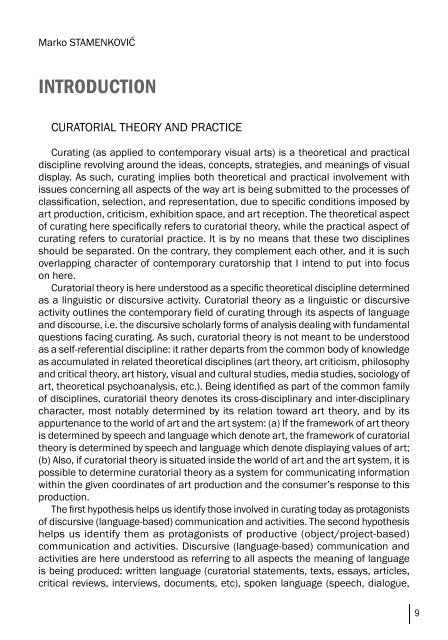art-e-conomy _ reader - marko stamenkovic
art-e-conomy _ reader - marko stamenkovic
art-e-conomy _ reader - marko stamenkovic
You also want an ePaper? Increase the reach of your titles
YUMPU automatically turns print PDFs into web optimized ePapers that Google loves.
Marko STAMENKOVIĆ<br />
INTRODUCTION<br />
CURATORIAL THEORY AND PRACTICE<br />
Curating (as applied to contemporary visual <strong>art</strong>s) is a theoretical and practical<br />
discipline revolving around the ideas, concepts, strategies, and meanings of visual<br />
display. As such, curating implies both theoretical and practical involvement with<br />
issues concerning all aspects of the way <strong>art</strong> is being submitted to the processes of<br />
classification, selection, and representation, due to specific conditions imposed by<br />
<strong>art</strong> production, criticism, exhibition space, and <strong>art</strong> reception. The theoretical aspect<br />
of curating here specifically refers to curatorial theory, while the practical aspect of<br />
curating refers to curatorial practice. It is by no means that these two disciplines<br />
should be separated. On the contrary, they complement each other, and it is such<br />
overlapping character of contemporary curatorship that I intend to put into focus<br />
on here.<br />
Curatorial theory is here understood as a specific theoretical discipline determined<br />
as a linguistic or discursive activity. Curatorial theory as a linguistic or discursive<br />
activity outlines the contemporary field of curating through its aspects of language<br />
and discourse, i.e. the discursive scholarly forms of analysis dealing with fundamental<br />
questions facing curating. As such, curatorial theory is not meant to be understood<br />
as a self-referential discipline: it rather dep<strong>art</strong>s from the common body of knowledge<br />
as accumulated in related theoretical disciplines (<strong>art</strong> theory, <strong>art</strong> criticism, philosophy<br />
and critical theory, <strong>art</strong> history, visual and cultural studies, media studies, sociology of<br />
<strong>art</strong>, theoretical psychoanalysis, etc.). Being identified as p<strong>art</strong> of the common family<br />
of disciplines, curatorial theory denotes its cross-disciplinary and inter-disciplinary<br />
character, most notably determined by its relation toward <strong>art</strong> theory, and by its<br />
appurtenance to the world of <strong>art</strong> and the <strong>art</strong> system: (a) If the framework of <strong>art</strong> theory<br />
is determined by speech and language which denote <strong>art</strong>, the framework of curatorial<br />
theory is determined by speech and language which denote displaying values of <strong>art</strong>;<br />
(b) Also, if curatorial theory is situated inside the world of <strong>art</strong> and the <strong>art</strong> system, it is<br />
possible to determine curatorial theory as a system for communicating information<br />
within the given coordinates of <strong>art</strong> production and the consumer’s response to this<br />
production.<br />
The first hypothesis helps us identify those involved in curating today as protagonists<br />
of discursive (language-based) communication and activities. The second hypothesis<br />
helps us identify them as protagonists of productive (object/project-based)<br />
communication and activities. Discursive (language-based) communication and<br />
activities are here understood as referring to all aspects the meaning of language<br />
is being produced: written language (curatorial statements, texts, essays, <strong>art</strong>icles,<br />
critical reviews, interviews, documents, etc), spoken language (speech, dialogue,<br />
9


